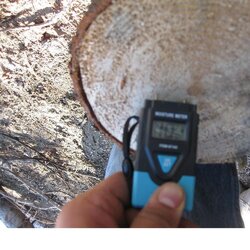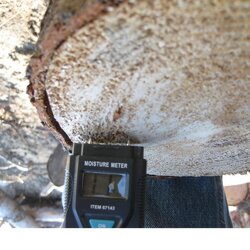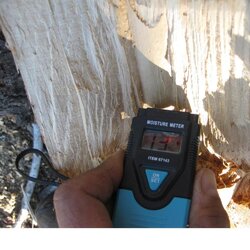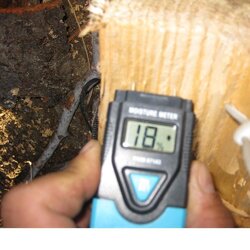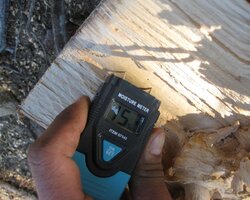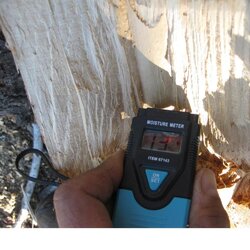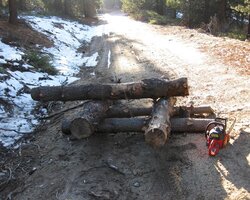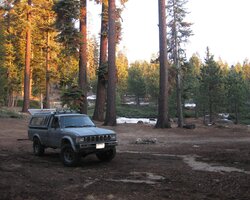I know that you are supposed to test a freshly cut split to get the proper reading. However, I am going to go forage for some wood this week and was wondering how accurate it would be to simply cut a round and do a quick measure of the fresh end grain to see if the moisture is low enough to burn this year. I know that I can always just take a maul and give it a whack but hey if I can conserve energy and oxygen the air up there is thin(7500ft elevation). Anyway thought I would see if anyone has tried this and what the comparison was from fresh end grain to fresh split.
Can moisture meter be used on end grain of a fresh cut round with any accuracy?
- Thread starter THEMAN
- Start date
-
Active since 1995, Hearth.com is THE place on the internet for free information and advice about wood stoves, pellet stoves and other energy saving equipment.
We strive to provide opinions, articles, discussions and history related to Hearth Products and in a more general sense, energy issues.
We promote the EFFICIENT, RESPONSIBLE, CLEAN and SAFE use of all fuels, whether renewable or fossil.
You are using an out of date browser. It may not display this or other websites correctly.
You should upgrade or use an alternative browser.
You should upgrade or use an alternative browser.
- Status
- Not open for further replies.
Very few if any dead standing trees will have a 20% or lower reading. If it is fresh cut, a reading from a cut end is accurate. When it becomes not accurate is when it has time to season, then the ends have lower reading then the middle.
If you need wood and you are going to to cut and burn dead standing trees, clean the chimney a lot! I'd say once a month.
Last year was my first year burning, and much of what I burned was dead standing wood, it sizzles, and there are a lot of ashes compared to seasoned wood. In the prefect world, we'd all be 2 or 3 years ahead, but it seems to me that only those who have burned at least 3 years are 3 years ahead.
If you need wood and you are going to to cut and burn dead standing trees, clean the chimney a lot! I'd say once a month.
Last year was my first year burning, and much of what I burned was dead standing wood, it sizzles, and there are a lot of ashes compared to seasoned wood. In the prefect world, we'd all be 2 or 3 years ahead, but it seems to me that only those who have burned at least 3 years are 3 years ahead.
THEMAN said:I know that you are supposed to test a freshly cut split to get the proper reading. However, I am going to go forage for some wood this week and was wondering how accurate it would be to simply cut a round and do a quick measure of the fresh end grain to see if the moisture is low enough to burn this year. I know that I can always just take a maul and give it a whack but hey if I can conserve energy and oxygen the air up there is thin(7500ft elevation). Anyway thought I would see if anyone has tried this and what the comparison was from fresh end grain to fresh split.
muncybob
Minister of Fire
Funny you should ask this...I am off from work today and plan to cut some standing dead trees and use my meter on them. I see no reason why a fresh cut round would read any differently than a fresh split of that round. Be sure the reading is from the center of the round. There is a large maple down that I plan to attack...a lot of the larger limbs are actually off the ground and I'm hoping they will be ready to burn this year.
mike1234 said:Very few if any dead standing trees will have a 20% or lower reading. If it is fresh cut, a reading from a cut end is accurate. When it becomes not accurate is when it has time to season, then the ends have lower reading then the middle.
If you need wood and you are going to to cut and burn dead standing trees, clean the chimney a lot! I'd say once a month.
Last year was my first year burning, and much of what I burned was dead standing wood, it sizzles, and there are a lot of ashes compared to seasoned wood. In the prefect world, we'd all be 2 or 3 years ahead, but it seems to me that only those who have burned at least 3 years are 3 years ahead.
THEMAN said:I know that you are supposed to test a freshly cut split to get the proper reading. However, I am going to go forage for some wood this week and was wondering how accurate it would be to simply cut a round and do a quick measure of the fresh end grain to see if the moisture is low enough to burn this year. I know that I can always just take a maul and give it a whack but hey if I can conserve energy and oxygen the air up there is thin(7500ft elevation). Anyway thought I would see if anyone has tried this and what the comparison was from fresh end grain to fresh split.
I'm not going to cut dead standing, I'm going to cut dead and fallen, we are not allowed to fell trees in good'ol California. I went last month before I had acquired the moisture meter and there was a few logs that would have produced quite a bit of wood but felt wet. They definitely had been down a while and I figured that the it was just moisture from the rain but didn't want to take the chance in having to cut it and load it and then have to wait for it to season, as I need wood I can burn this year. Of the other logs we cut one felt slightly wet but we took it anyway. When I got to town I purchased a meter and started splitting. All the wood even the "wet" one was under 22% in all but the outside 1/2 inch of the split. I was very relieved. I now want to go up and get some more wood and just wanted to know if a fresh cut round would suffice so hence the question.
Someone here had posted a link about using a multimeter to read moisture - that article (or maybe something else I read) said that there is a difference along the grain versus cross grain. It may not be enough to make a difference unless it's furniture grade lumber.
Just to be safe, take a maul and split one round to test both ways - if it's close then you're all set, if it's not you still can use the end grain reading as a SWAG.
Aaron
Just to be safe, take a maul and split one round to test both ways - if it's close then you're all set, if it's not you still can use the end grain reading as a SWAG.
Aaron
Aaron Pasteris said:Someone here had posted a link about using a multimeter to read moisture - that article (or maybe something else I read) said that there is a difference along the grain versus cross grain. It may not be enough to make a difference unless it's furniture grade lumber.
Just to be safe, take a maul and split one round to test both ways - if it's close then you're all set, if it's not you still can use the end grain reading as a SWAG.
Aaron
Agreed on the SWAG haha. I'm going up in the morning and will take my axe to split a few pieces and see if there is any type of consistency between the two readings. I will report later that evening if I'm not too tired.
Well went up today and got me some wood. I cut some rounds and measured from the center across the grain (10%) and towards the edge across the grain(11%). I then split the round and measured center across the grain(13%) and at the edge across the grain(18%). The results were pretty close +/- 7%. Enough for me to decide if I wanted to continue cutting the log and bring the wood home or leave it and search for more "ready to burn" wood. Here are the pics of the results.
Attachments
The fallen stuff is seasoned, and they can't fell dead standing trees in CA. I would say that might add to the wild fire's getting out of control. What's in the ocean water that makes many CA politicians ..... lets say lack common sense?gzecc said:Wow, thats some dry wood in the round. No wonder why your wild fires are so bad. Its fed by seasoned firewood!
Nothing I cut that is down, in fact none of the wood I cut and split last winter, has 10 or 11 or 12% moisture. Nice find.
Lumber-Jack
Minister of Fire
You must live in a very wet area Mike because that's pretty much all I cut is standing dead, Pine or Fir and I plan on burning same year, so it must be less than 20% or I won't burn it.mike1234 said:Very few if any dead standing trees will have a 20% or lower reading.
Granted most standing dead trees I cut will often have higher moisture content in the wood at the base of the tree than a little higher up, but even that wood at the base is usually no higher that 30% and that is usually confined to the first 2-3 rounds off the very bottom and the rest is < 20%.
This year I found a place where the logging company fell a lot of pine beetle kill along the road, I believe they did this so they wouldn't blow down on their own and possibly block the road. Anyway, there was plenty of trees along the road already fallen and ready to buck up and haul away. What I found was that the fallen trees actually measured a bit higher moisture content through out then the standing dead trees around them. I chalk this up top the fact that the trees were lying on their side all winter and absorbing rain and snow, where the standing dead trees were tall and vertical, with the majority of their surface exposed to the sun and wind.
Anyway, the fallen ones were still only in the low 20% and quickly dried to < 15% after being cut, split and stacked.
Here is a standing dead tree I fell this last September and took a moisture reading on the stump right after I fell the tree.
Below is a picture of the freshly cut stump and moisture meter.
Here is a link to a picture of the moisture reading, I left the picture full size so you can clearly read the moisture level.
rathmir
New Member
I'd like to see if there's a difference between a reading taken across the grain (as shown in post #8) vs along the grain (in other words within the same growth ring). The article that was posted earlier this month about using a multimeter stated that you had to measure with the grain or the resistance would increase, showing falsely low readings.
rathmir said:I'd like to see if there's a difference between a reading taken across the grain (as shown in post #8) vs along the grain (in other words within the same growth ring). The article that was posted earlier this month about using a multimeter stated that you had to measure with the grain or the resistance would increase, showing falsely low readings.
OK here is are the pics with the measure taken from the center of the split with the grain and across the grain.
Attachments
rathmir
New Member
Lumber-Jack
Minister of Fire
He he, I'm gona have to change my Avatar, it seems to be too distracting to some forum members. %-Pgzecc said:The only wood we have in the north east US that has reading that low is trim that has been installed in houses. Lets forget about the stump pictures and get more of the woman on your avatar.
I can't say I agree with that false reading with the grain/across the grain stuff. I have tried all the different ways trying to get different readings and as long as you push the probes in deep enough it seems to give the same, or very similar, readings. The biggest differences I find are in reading the outside surface of the wood as opposed to freshly splitting or cutting open the wood and taking an inside reading. You can't go by an outside reading, you gota cut, or split, the wood open to get a true reading.rathmir said:I'd like to see if there's a difference between a reading taken across the grain (as shown in post #8) vs along the grain (in other words within the same growth ring). The article that was posted earlier this month about using a multimeter stated that you had to measure with the grain or the resistance would increase, showing falsely low readings.
Carbon_Liberator said:He he, I'm gona have to change my Avatar, it seems to be too distracting to some forum members. %-Pgzecc said:The only wood we have in the north east US that has reading that low is trim that has been installed in houses. Lets forget about the stump pictures and get more of the woman on your avatar.
I can't say I agree with that false reading with the grain/across the grain stuff. I have tried all the different ways trying to get different readings and as long as you push the probes in deep enough it seems to give the same, or very similar, readings. The biggest differences I find are in reading the outside surface of the wood as opposed to freshly splitting or cutting open the wood and taking an inside reading. You can't go by an outside reading, you gota cut, or split, the wood open to get a true reading.rathmir said:I'd like to see if there's a difference between a reading taken across the grain (as shown in post #8) vs along the grain (in other words within the same growth ring). The article that was posted earlier this month about using a multimeter stated that you had to measure with the grain or the resistance would increase, showing falsely low readings.
I agree with measuring the inside. Usually the outside of a log would give you a dryer reading than the inside of a split. In my case however as you can see in the pic, they already had some snowfall and the logs would give a higher reading on the outside than the inside. This is why I wanted to know about cutting a log and getting a quick reading to see if once split it would be somewhat close to the cut reading. I found that it was close enough for me to carry the damn log down the hill to cut. I sure would have been upset to have carried a bunch of logs down the hill only to find out that they were over 35% and although good wood not good for burning this year. I did split some of the rounds and found that about an inch of the outer edge quite a bit higher moisture % than the center. Absorbed moisture from being on the ground. I figure that when I get to these logs in a few months that that moisture will have evaporated since they will have been split up off the ground and had some time to dry. It was pretty nice up there, and since this is a 'gear' section I will through in part of my foraging gear. My little hunting truck that my wife hates. haha. Whoops too big see next posting for truck pic
Attachments
THEMAN said:Carbon_Liberator said:He he, I'm gona have to change my Avatar, it seems to be too distracting to some forum members. %-Pgzecc said:The only wood we have in the north east US that has reading that low is trim that has been installed in houses. Lets forget about the stump pictures and get more of the woman on your avatar.
I can't say I agree with that false reading with the grain/across the grain stuff. I have tried all the different ways trying to get different readings and as long as you push the probes in deep enough it seems to give the same, or very similar, readings. The biggest differences I find are in reading the outside surface of the wood as opposed to freshly splitting or cutting open the wood and taking an inside reading. You can't go by an outside reading, you gota cut, or split, the wood open to get a true reading.rathmir said:I'd like to see if there's a difference between a reading taken across the grain (as shown in post #8) vs along the grain (in other words within the same growth ring). The article that was posted earlier this month about using a multimeter stated that you had to measure with the grain or the resistance would increase, showing falsely low readings.
I agree with measuring the inside. Usually the outside of a log would give you a dryer reading than the inside of a split. In my case however as you can see in the pic, they already had some snowfall and the logs would give a higher reading on the outside than the inside. This is why I wanted to know about cutting a log and getting a quick reading to see if once split it would be somewhat close to the cut reading. I found that it was close enough for me to carry the damn log down the hill to cut. I sure would have been upset to have carried a bunch of logs down the hill only to find out that they were over 35% and although good wood not good for burning this year. I did split some of the rounds and found that about an inch of the outer edge quite a bit higher moisture % than the center. Absorbed moisture from being on the ground. I figure that when I get to these logs in a few months that that moisture will have evaporated since they will have been split up off the ground and had some time to dry. It was pretty nice up there, and since this is a 'gear' section I will through in part of my foraging gear. My little hunting truck that my wife hates. haha. Whoops too big see next posting for truck pic
Truck pic
Attachments
Lumber-Jack
Minister of Fire
By looking at those logs, with the bark falling off, I'm sure they would be well "seasoned", just a mater of drying out the surface moisture,,, same as the downed trees I was dealing with.
Does look nice up there, must have been around sunset.
Does look nice up there, must have been around sunset.
Carbon_Liberator said:By looking at those logs, with the bark falling off, I'm sure they would be well "seasoned", just a mater of drying out the surface moisture,,, same as the downed trees I was dealing with.
Does look nice up there, must have been around sunset.
Yeah was around 5ish, it is beautiful up there I love going up there. Usually only for hunting and camping but now for wood gathering. Woowoo another excuse to get up there. That will probably be the last time I go up there this year, they were expecting a storm that evening and tonight, so we were kind of having to hurry it up at that point. Didn't want to get caught in the storm an have to chain up. The logs were pretty dry as you can see from the meter readings. Some were a bit wet but as you said surface moisture that should burn off in no time.
- Status
- Not open for further replies.
Similar threads
- Replies
- 24
- Views
- 3K
- Replies
- 2
- Views
- 1K
- Replies
- 19
- Views
- 4K
- Replies
- 19
- Views
- 4K


